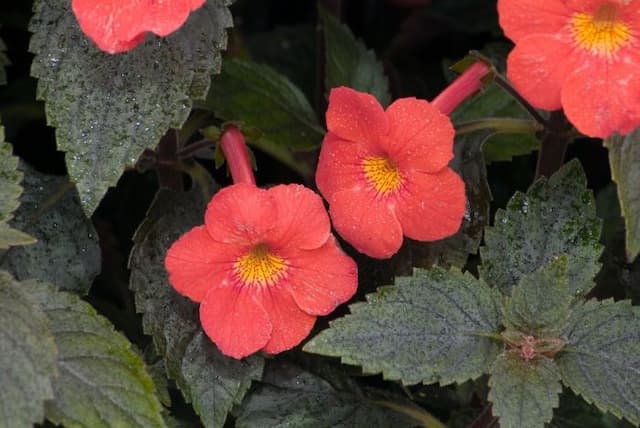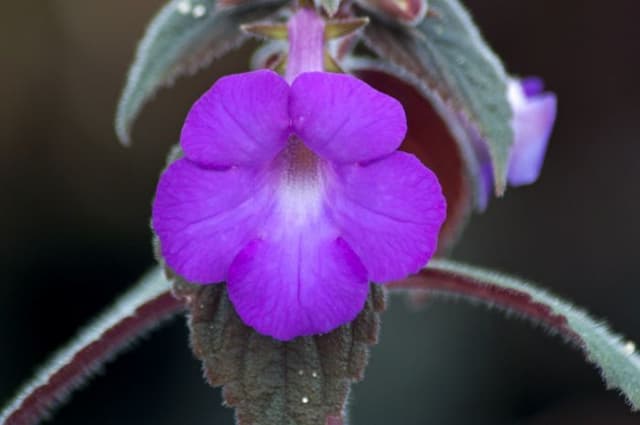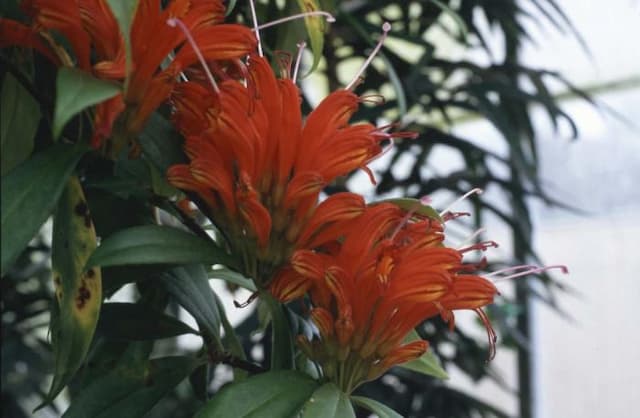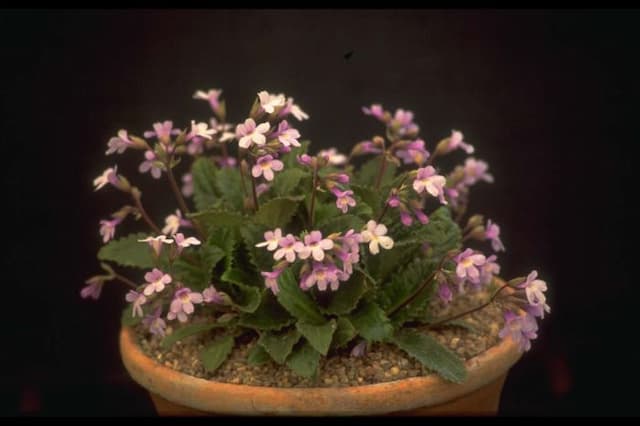Gloxinia Sinningia Empress Series

ABOUT
The Sinningia Empress Series, commonly known as Gloxinia, is a visually striking plant with a bold and vibrant appearance. It is characterized by its large, velvety leaves that form a dense rosette at the base. The foliage is deeply green, creating a lush and luxurious backdrop for the flowers. These leaves often have a slightly scalloped or wavy edge, adding texture and depth to the plant's overall look. The flowers of the Gloxinia in the Empress Series are particularly captivating. They are large and bell-shaped, with a flared mouth, making them resemble trumpets. These blossoms come in a range of rich colors, including shades of red, pink, purple, and white, some with attractive speckles or contrasting color throats. The flowers are often edged in a delicate lighter color or white, giving them a dramatic and elegant appearance. The blooms rise above the foliage on short, sturdy stalks, and due to the breeding of this series, they display an impressive show of color, with the floral display being both abundant and long-lasting. The overall aspect of the Gloxinia in the Empress Series is one of opulence and beauty, making it a popular choice for indoor decoration. Despite its showy nature, it does not have a fragrant presence, letting its visual charm be the primary sensory appeal.
About this plant
 Names
NamesFamily
Gesneriaceae
Synonyms
Gloxinia, Empress Gloxinia
Common names
Sinningia speciosa 'Empress'
 Toxicity
ToxicityTo humans
The plant commonly known as Gloxinia (Sinningia Empress Series), to the best of my knowledge, is not considered toxic to humans. There are no well-documented cases of Gloxinia causing serious poisoning in humans, and it is generally considered safe around children and adults. However, it's always a good practice to avoid ingesting any part of houseplants and ornamentals, as individual allergic reactions or gastrointestinal disturbances can occur from ingesting plant matter that humans are not typically exposed to.
To pets
The common Gloxinia (Sinningia Empress Series) is not known to be toxic to pets such as cats and dogs. This ornamental plant is typically safe to keep in homes with pets, as it doesn't contain known toxins that can cause serious harm if ingested. Nonetheless, it's still a good precaution to prevent pets from chewing on plants, as ingestion could potentially lead to mild gastrointestinal irritation or an allergic reaction in sensitive animals.
 Characteristics
CharacteristicsLife cycle
Perennials
Foliage type
Deciduous
Color of leaves
Green
Flower color
Varies
Height
1 foot (30 cm)
Spread
1 foot (30 cm)
Plant type
Bulb
Hardiness zones
10
Native area
Brazil
Benefits
 General Benefits
General Benefits- Vibrant Appearance: The Sinningia Empress, commonly known as “Gloxinia,” has large, velvety flowers that add a vivid splash of color to any indoor setting.
- Long Blooming Period: Gloxinias are known for their prolonged blooming times, providing an extended display of their attractive flowers.
- Easy Care: While they require specific conditions, once these are met, Gloxinias are relatively low-maintenance and are suitable for gardeners of varying experience levels.
- Compact Size: This plant remains relatively small, making it an ideal choice for windowsills, desktops, and other limited spaces.
- Variety: The Empress Series offers a range of colors and patterns, allowing for personalization of decor and collection.
- Emotional Wellbeing: The presence of flowering plants such as Gloxinias can contribute to reduced stress levels and enhanced mood.
 Medical Properties
Medical PropertiesThis plant is not used for medical purposes.
 Air-purifying Qualities
Air-purifying QualitiesThis plant is not specifically known for air purifying qualities.
 Other Uses
Other Uses- Sinningia, commonly known as Gloxinia, can be used for educational purposes, such as teaching plant biology or horticulture due to its interesting tuberous growth and flowering habits.
- Gloxinias, with their lush blooms, can be a muse for artists and photographers looking to capture the essence of floral beauty in their work.
- In terrariums, smaller varieties of Sinningia can be incorporated to create miniature landscapes within glass containers.
- As a participant in flower shows, Gloxinias can be grown and groomed for competition to win titles for their beauty and form.
- Gloxinias can be used in sensory gardens because of their soft, velvety leaves and vibrant flowers which provide tactile and visual stimuli.
- In crafting, the vibrant flowers of the Gloxinia can be used as natural dyes to impart color on fabrics or paper.
- During festive seasons, Gloxinias can be given as a living gift that symbolizes warmth and affection.
- Breeders can use Sinningia varieties in hybridization efforts to create new cultivars with unique characteristics.
- As a centerpiece, Gloxinia plants can adorn event tables, adding a touch of natural elegance to any social gathering.
- Gloxinias can also serve as a natural humidifier, releasing moisture into the air through transpiration, which can be beneficial in dry indoor environments.
Interesting Facts
 Feng Shui
Feng ShuiThe Sinningia, commonly known as Gloxinia, can enhance Feng Shui when used as a symbol of growth and renewal. It can be placed in areas where you want to foster personal growth or improve relationships, like the Family (East) or Relationship (Southwest) sectors of your home.
 Zodiac Sign Compitability
Zodiac Sign CompitabilityThe Gloxinia is not used in astrology practice.
 Plant Symbolism
Plant Symbolism- Royalty: Given its name "Empress," the Sinningia is often associated with regality, dignity, and the luxurious beauty seen in royal gardens.
- Refinement: The delicate and ornate flowers of the plant symbolize a sense of sophistication and elegance.
- Innovation: As a plant cultivated through careful breeding and selection, it represents human creativity and the quest for horticultural perfection.
- Resilience: Sinningia, as a genus, is known for its ability to thrive with minimal care and in relatively harsh conditions, symbolizing endurance and adaptability.
 Water
WaterWater the Gloxinia, also known as Sinningia Empress Series, when the top inch of soil feels dry to the touch, which might be roughly once a week, but this frequency can vary based on the environmental conditions, particularly humidity and temperature. Use room temperature water and gently water the soil around the plant until water starts to drain out the bottom, indicating that the soil is saturated. This could be approximately 8-16 ounces for a standard 6-inch pot, depending on pot size and the plant's growth stage. Over-watering can cause root rot, so ensure the pot has good drainage and avoid letting the plant sit in standing water.
 Light
LightGloxinias prefer bright, indirect light away from direct sunlight that can scorch their leaves. A north or east-facing windowsill is an ideal spot, as it will provide the gentle, filtered light Gloxinias thrive in. These plants can also flourish under fluorescent grow lights if a suitable natural light source is not available.
 Temperature
TemperatureGloxinias grow best in temperatures between 60 to 75 degrees Fahrenheit, making them ideal for typical indoor conditions. They should not be exposed to temperatures below 50 degrees Fahrenheit, as cold drafts can damage the plant. Keeping your Gloxinia in a stable environment away from cold windows in the winter and hot, direct sun in the summer will help it thrive.
 Pruning
PruningPrune your Gloxinia to encourage bushier growth and remove spent flowers to promote further blooming. After the flowers fade, cut off the flower stem close to the base of the plant. Pruning is best done after the blooming cycle, usually in the fall, preparing the plant for a period of rest during the winter months.
 Cleaning
CleaningAs needed
 Soil
SoilThe best soil mix for the Gloxinia (Sinningia Empress Series) is a well-draining, rich potting mix with added perlite or vermiculite for aeration. It prefers a slightly acidic to neutral pH between 5.5 and 7.0.
 Repotting
RepottingGloxinias should be repotted every 1-2 years or when they become root-bound. It's best to repot after the flowering period when the plant is entering dormancy.
 Humidity & Misting
Humidity & MistingGloxinias thrive in high humidity levels, ideally between 50-60%. They benefit from a humid environment but require good air circulation to prevent disease.
 Suitable locations
Suitable locationsIndoor
Provide bright, indirect light and keep soil moist.
Outdoor
Shelter from direct sun and heavy rain; bring inside if cold.
Hardiness zone
10-11 USDA
 Life cycle
Life cycleThe Sinningia speciosa, commonly known as the Florist's Gloxinia, begins its life cycle when a seed germinates in moist, well-draining soil under warm, indirect light. The seedling then emerges and develops into a rosette of velvety leaves, a phase where it focuses on establishing a strong root system and foliage growth. As the plant matures, it enters the flowering stage, producing large, bell-shaped flowers that can be of various colors, depending on the cultivar. After blooming, which may last several weeks, the plant goes into a dormancy period where the foliage dies back, signaling a rest phase that is vital for the next growth cycle. During dormancy, it's important to reduce watering to prevent rot, and store the tuber in a cool, dry place until the next growing season. With the return of favorable conditions, the Florist's Gloxinia will resume growth from the tuber, repeating its life cycle with the production of new leaves and another flowering phase.
 Propogation
PropogationPropogation time
Spring to Summer
The most popular method of propagation for the Sinningia Empress Series, commonly known as the Gloxinia, involves the use of leaf cuttings. This method is typically carried out during the plant's active growing season, which is spring and summer. A healthy leaf is selected and cut from the plant, with the petiole (leaf stalk) intact. The cut end of the petiole is then dipped in rooting hormone to encourage root development. This prepared cutting is placed in a moist, well-draining potting mix or a blend of peat and perlite. The pot with the leaf cutting should be kept in a warm environment with indirect light, and the soil should be kept consistently moist but not waterlogged. In a few weeks, new growth should begin to appear, indicating that the leaf cutting has successfully taken root.









